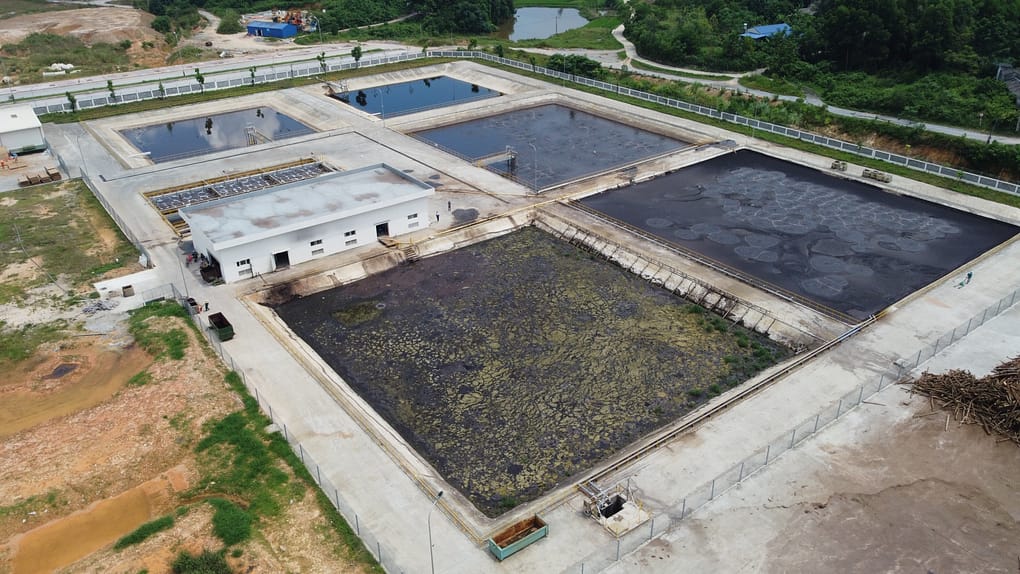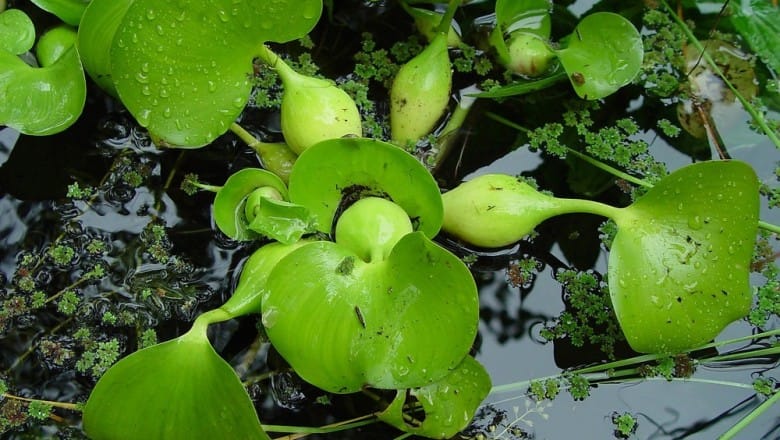Waste sludge treatment after wastewater treatment is still complicated. Because most of the heavy metals are deposited in the sludge.
Current status of sludge treatment in Southeast industrial zones
According to the Global Waste Survey of the International Maritime Organization: For every $1 billion in the gross domestic product (GDP) generated, 4,500 tons of industrial waste will be generated, of which 20% is hazardous waste. harmful.
Below is a table of forecasted sludge emissions to 2025 of the Southeast provinces:
| No. | Industrial zones, EPZs | Current sludge volume (Ton/month) | Forecast 2025 (Ton/month) |
| 1 | Ho Chi Minh City | 772,30 | 9.149,50 |
| 2 | Binh Duong province | 386,86 | 1.870,94 |
| 3 | Binh Phuoc province | 120,50 | 2.450,77 |
| 4 | Tay Ninh province | 125,20 | 2.325,10 |
| 5 | Ba Ria – Vung Tau province | 90,70 | 291,76 |
| 6 | Dong Nai province | 370,60 | 459,403 |
| 7 | Total | 1.866,16 | 16.547,47 |
Ho Chi Minh City
According to HEPZA, all industrial parks and export processing zones of Ho Chi Minh City have built centralized wastewater treatment plants. The average total treatment capacity is about 44,000 m3/day out of the total design capacity of the wastewater treatment stations of the EPZs and IZs, which is 70,300 m3/day.
Assuming that from 2019 to 2020, industrial zones and export processing zones in the city will reach 95%. The rate of connection of enterprises to the centralized wastewater treatment system and the period of 2019 - 2025 will complete 100% of this work.
It is forecasted that by 2025, the total amount of biological sludge will be 2,086.1 tons and the amount of mixed sludge will reach 9,149.5 tons/per year. Emission levels in industrial zones and export processing zones range from 0.008 to 1,935 (tons/ha/month). Which, Linh Trung 1 Industrial Park has the highest emission level (1,935 Tons/ha/month), followed by Binh Chieu Industrial Park with 0.731 (tons/ha/month). Tan Thoi Hiep Industrial Park, District 9 Hi-Tech Park has the lowest emission level of 0.008 (tons/ha/month).
Binh Duong Province
Concentrated wastewater treatment plants in Binh Duong Industrial Park generate a relatively large amount of sludge, estimated at 552 - 545 tons/month; in which mixed sludge is the main, accounting for 51.98% (287.2 tons/month). Physical and chemical sludge has the least volume with 29,145 tons/month, accounting for about 5.27%. The amount of sludge from the concentrated wastewater treatment process between industrial zones has an enormous difference with the maximum volume of 225 tons/month, and the lowest being 0.05 tons/month.
The coefficient of sludge generation in industrial zones in Binh Duong province is from 0.005 to 2 kg/m3. Which, Kim Huy Industrial Park has the largest sludge emission coefficient (2 kg/m3); next is Song Than 2 Industrial Park. There are 3 IPs with the lowest emission factor of 0.005 kg/m3, including Binh Duong Industrial Park, VSIP I, and VSIP II. The forecasted sludge volume by 2020 will be 2.5 times higher than the present time.
Dong Nai province
According to statistics, it can be estimated that the average sludge emission coefficient of industrial zones in Dong Nai province is 0.15 tons/ha/month, higher than that of some neighboring provinces. close. According to the forecast results, the volume of sludge generated in industrial zones in Dong Nai province by 2025 is about 459,403 tons/month, an increase of 1.23 times compared to the current period.
Ba Ria - Vung Tau Province
There are 9 industrial zones in the province that have been put into operation. Which 8/9 IPs have centralized wastewater treatment systems and come into stable operation?
According to survey data in 8 industrial zones in Ba Ria - Vung Tau province, it can be estimated that the average sludge emission coefficient of industrial zones in Ba Ria - Vung Tau province is 0.036 tons/ha/month.
According to the forecast results, the volume of sludge generated in industrial zones in Ba Ria - Vung Tau province is 291.76 tons/month, an increase of 3.21 times compared to the current period. The large volume of sludge from wastewater treatment systems has the potential to cause great pollution if not effectively controlled, managed, and treated.
Binh Phuoc Province
According to the research results, the sludge emission coefficient of industrial zones in Binh Phuoc province is from 05 to 120 tons/ha/month. The sludge emission coefficient of Binh Phuoc Industrial Park is quite large, so the amount of sludge generated by 2025 is very large, about 2,450 tons/month.
Tay Ninh province
Industrial zones and EPZs in Tay Ninh province are still in the stage of investment and expansion. Enterprises invest heavily in Thanh Cong Industrial Park and Trang Bang Industrial Park and gradually reduce investment in Cha La Industrial Park.
Research results show that Phuoc Dong - Boi Loi Industrial Park has the lowest emission factor when only 0.008 (ton/ha/month), and Linh Trung 3 EPZ & Industrial Park has the highest emission level of 0.296 tons/ha/ month.
It is forecasted that by 2025, the amount of sludge generated from industrial zones in the whole province is 2,325.1 tons with 1,177.4 tons of biological sludge and 1,147.7 tons of physicochemical sludge [3]. With the industrial economy gradually going up, investment in sludge treatment facilities in the future is necessary for Tay Ninh province.
Thus, the volume of sludge after the wastewater treatment system in industrial zones in 6 provinces in the Southeast region is 16,547.47 kg/month, an increase of 8.87 times compared to the currently generated sludge volume.
Criteria for classifying types of sewage sludge
First, environmental management agencies need to set standards for classifying waste sludge, which can be roughly divided into the following categories:
– Biological sludge: Has a stench but is not toxic. Can produce organic fertilizer by adding the lime powder to reduce acidity; peat; microbiological culture, using EM ... to deodorize, will become synthetic organic fertilizer. Which, sludge accounts for 70%. The price is cheap; the quality is not inferior to the organic fertilizers sold on the market.
– Non-toxic industrial sludge: No need to treat, can be used for many purposes.
– Hazardous industrial sludge: Containing heavy metals such as Cu, Mn, Zn, Ni, Cd, Pb, Hg, Se, Al, As... must be treated before being discharged into the environment, if would not pose a threat too many generations to come.

See more: sludge treatment project for wood processing factory
Treating hazardous sludge "by biotechnology"
Many scientists are especially interested in low investment costs, safety, and environmental friendliness.
Scientists say that there are about 400 species of plants, grasses, and algae ... capable of absorbing heavy metals, and cleaning the environment of soil and water... those plants must have the ability to quickly biomass and accumulate concentrations. High metal, easy to harvest:
According to foreign information:
Vetiver grass
Vetiver grass can absorb most heavy metals: As, Cd, Hg, Pb, Ni, Cu, Cr… Recently, the "International vetiver network" sponsored the program "Improving water quality in Vietnam". Vietnam” by planting vetiver grass in dioxin-contaminated areas in the A-Lai region (Hue).

Over 70 countries around the world have grown vetiver grass with the main purpose of preventing landslides and erosion... in riverbanks, like banks, and hilly areas, and cleaning up the water environment.
By the hydroponic method, China has used vetiver grass to clean Taihu freshwater lake an area of 2,420 km2, and contains 4,870 million m3 of water. The result is a 99% reduction in soluble P after 3 weeks and 74% in soluble N after 5 weeks, absorbing many heavy metals As, Cd, Hg, Pb, Ni, Cu, Cr... preventing the development of blue-green algae, it is easy to harvest 20-30 tons of aromatic roots/year/ha to distill essential oils for cosmetic industry (contains 2-3% essential oils).
Propose
The environmental regulatory agency needed for testing. Using about 1,000m2 of poor soil, digging about 1m deep, lining 2 layers of HDPE below, beveling the surrounding bank, and then filling it with hazardous sludge (with heavy metal indicators). Then, plant vetiver on the test plot. After about 6 months, the soil will be tested again. If there are still heavy metals, the testing time will be longer. In the dry season, wastewater from lakes can collect mud to irrigate grass fields. Implement wastewater treatment by "irrigation field" technology. If successful with this method, both hazardous sludge and wastewater containing heavy metals can be treated.
In addition, there are many other types of plants that also have the effect of cleaning the environment, such as dandelion, reed, etc., which need to be studied.
Water hyacinth
Water hyacinth is a quick-growing aquatic plant. The biggest effect of water hyacinths on humans is to contribute to the purification of water sources and the decomposition of toxic substances. According to foreign documents, water hyacinths can absorb: Na, Ca, P, Mn, Phenol, Hg, Al, and Zinc, and decompose several other toxic substances ... it is very necessary to be studied carefully in water conditions. ta.

Recommendations: Wastewater ponds need to be released, can be "diluted" because too dense, the water will lack oxygen, water hyacinth is difficult to grow and develop... combine with "vetiver hydroponics".
The application of biotechnology to the treatment of heavy metals in sludge as well as wastewater is of interest to many scientists, because there are many prospects with low cost and environmental friendliness, but it is still in the early stages. experiment, needs the investment of the State and encourages scientists at institutes and universities to delve into this technology, because there are still many problems that need to be answered in a scientific and specific way...
Current sludge management and treatment solutions
Waste sludge is currently managed under the Law on Environmental Protection (Article 100), Decree 80/2014/ND-CP; Decree 38/2015/ND-CP (Article 40); Circular No. 36/2015/TT-BTNMT; Official Letter No. 3345/BTNMT-TCMT. Accordingly, most types of sludge from the wastewater treatment process of industries are classified as hazardous waste (HW). In addition, certain types of sludge that have not been proven to be non-hazardous must be managed according to the regulations for hazardous wastes.
Currently, the management of sludge from centralized wastewater treatment systems of industrial zones is subject to the following regulations and treatment processes: Sludge compaction tank --> sludge dewatering --> sludge drying yard --> Collection and handling. The sludge dewatering machine is Screw Press and decanter. Very few IPs use filter press..
Conclusion
Sludge in the wastewater treatment system of industrial zones not only affects the treatment costs of investors but is also a difficult problem, challenging State agencies to find solutions to treat the above sludge. The priority direction is to reduce and reuse this amount of resources, and it must be handled in the right process to minimize pollution.
Industrial zones need to research to minimize biological sludge formation by optimizing the operation process, using microorganisms to reduce sludge volume, and separating biological sludge from physicochemical sludge to reduce the volume of sludge to be treated. Physical. In industrial zones with biological sludge that is not hazardous sludge, it is necessary to reuse the sludge as compost to reduce the cost of sludge treatment. Take advantage of microorganisms and nutrients in the sludge as a soil improver.
It is necessary to use a decanter centrifuge, which increases the efficiency of sludge drying and reduces the cost of treatment. In addition, sewage sludge needs to be managed strictly according to current circulars and documents to ensure that it does not pollute the environment after disposal or treatment.
When building a sludge treatment system. If the Enterprise needs to buy a sludge press(DECANTER CENTRIFUGE, Screw Press, belt press). Please contact ARK Vietnam for testing and dedicated advice.
